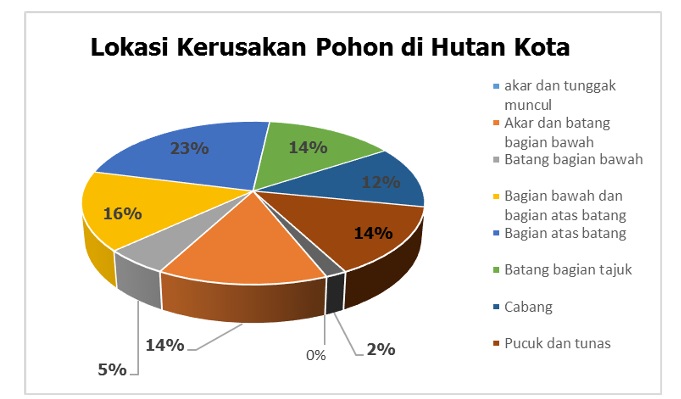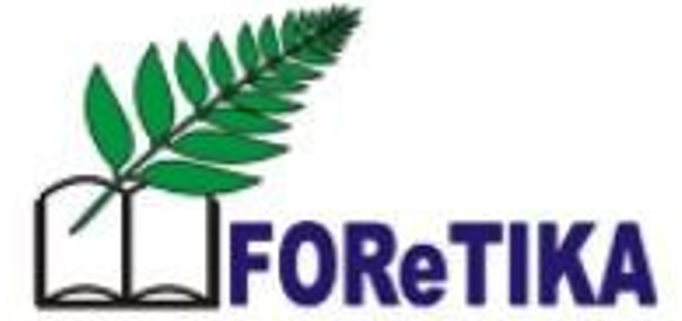Analisis Kesehatan Pohon di Hutan Kota Selong dan Taman Rinjani Kota Selong Kabupaten Lombok Timur
Analysis of Tree Health in Selong City Forest and Rinjani Park, Selong City, East Lombok Regency
DOI:
https://doi.org/10.22219/avicennia.v7i1.31833Keywords:
Kesehatan Pohon, FHM, Hutan Kota Selong, Taman Rinjani Kota SelongAbstract
Abstract
The green open spaces of Selong City Forest and Rinjani Park Selong City are areas that are used by the community to support economic, social, sports, and educational activities. The large number of activities carried out in the green open space can affect the health of the trees and it is feared that this will impact the safety of the visitors. This research aims to determine the health condition of trees in the Selong City Forest and Rinjani Park Selong City using the Forest Health Monitoring (FHM) method. Health measurements and assessments were carried out on all trees in the Selong City Forest were in healthy condition with an interval of (0-3,8) totaling 219 trees (93,3%) while for trees in the Rinjani Park Selong City which is in the healthy category with an interval of (-3,19) has 63 trees (90%). This shows that all the trees are in healthy condition both in the Selong City Forest and Rinjani Park, Selong City.
Key Words: Tree Health, FHM, Selong City Forest, Rinjani Park Selong City.
Abstrak
Ruang terbuka hijau Hutan Kota Selong dan Taman Rinjani Kota Selong merupakan kawasan yang dimanfaatkan oleh masyarakat sebagai penunjang dalam kegiatan ekonomi, sosial, olahraga, dan pendidikan. Banyaknya aktivitas yang dilakukan di RTH tersebut dapat mempengaruhi kesehatan pohon dan dikhawatirkan berdampak terhadap keselamatan pengunjung. Tujuan dilakukannya penelitian ini adalah untuk mengetahui kondisi kesehatan pohon di Hutan Kota Selong dan Taman Rinjani Kota Selong dengan menggunakan metode Forest Health Monitoring (FHM). Pengukuran dan penilaian kesehatan dilakukan terhadap seluruh pohon dan pengukuran dilakukan secara sensus dan hasil penelitian menunjukkan pohon di Hutan Kota Selong berada pada kondisi sehat dengan interval sebesar (0–3,8) berjumlah 219 pohon (93,3%) sementara untuk pohon di Taman Rinjani Kota Selong yang berada pada kategori sehat dengan interval sebesar (0–3,19) berjumlah 63 pohon (90%). Hal ini menunjukkan bahwa seluruh pohon berada dalam kondisi sehat baik di Hutan Kota Selong maupun di Taman Rinjani Kota Selong.
Kata Kunci : Kesehatan Pohon, FHM, Hutan Kota Selong, Taman Rinjani Kota Selong.
Downloads
References
Abimanyu, B., Safe’i, R., & Hidayat, W. (2019). Aplikasi metode Forest Healtj Monitoring dalam penilaian kerusakan pohon di Hutan Kota Metro. Jurnal Sylva Lestari. 7(3), 289-298.
Arisanti, S., Nasrullah, N., & Sulistyantara, B. (2022). Evaluasi kerusakan fisik pohon dalam upaya menghadirkan pohon jaulr hijau yang aman di kota padang. https://doi.org/10.29244/jli.v14i2.40196.
Danniswari, D., Nasrullah, N., & Suliyantara, B. (2019). Fenologi perubahan warna daun pada Termalia catappa , Ficus glauca dan Cassia fistula. Jurnal Lanskap Indonesia, 11(1), 17–25.
Elmayana, & Rita, R. N. D. (2022). Identifikasi kesehatan pohon di jalur Hijau Kota Selong Kabupaten Lombok Timur. Jurnal Silva Samalas, 5(1), 31–44.
Fancel, C., & Muhamad. (2020). Pembangunan kota hijau Indonesia. Yogyakarta: Gadjah Mada University Press.
Fernando, A. A. F., Winarno, G. D., Safe’i, R., & Indriyanto. (2022). Penilaian kerusakan pohon aibat aktivitas wisata di bumi perkemahan kubu perahu Taman Nasional Bukit Barisan Selatan (TNBBS). Jurnal Hutan Tropis. 10(1), 30–37.
Fikri, K., Latifah, S., Mahakam, I., & Aji, L. (2023). Identifikasi Tipe Kerusakan Pohon di RTH Kampus Universitas Mataram. Jurnal Avicennia. 06(37), 12–25. https://doi.org/10.22219/avicennia.v6i1.21637.
Mahrup, Kusnartha, I., Soemeinaboedhy, Padusung, & Fahrudin. (2021). Lokus anomali vektor angin yang berdampak pada kekeringan di Nusa Tenggara Barat. 3(1), 9–10.
Makhfirah, N., Utami, D., Sena, F., Mardina, V., & Rimadeni, Y. (2021). Identification of types of damage to trees found in the protected forest tour of Langsa City. Jurnal Jeumpa.8(1), 462–471.
Negara, H. K., Rachmawati, N., & Payung, D. (2019). Pine tree damage identification in Banjarbaru's urban forest. Jurnal Sylva Scienteae. 02(4), 635–644.
Ningrum, L. W. (2020). Pemantauan pohon beresiko patah / tumbang di sepanjang pagar utara Kebun Raya Purwodadi. 19(11), 243–252.
Pertiwi, D., & Kaskoyo, H. (2019). Identifikasi kondisi kerusakan pohon menggunakan metode Forest Health Monitoring di Tahura War Provinsi Lampung. Jurnal Perennial. 15(1), 1–7.
Safe'i, R., & Tsani, K.M. (2016). Penilaian kesehatan hutan menggunakan teknik Forest Health Monitoring. Yogyakarta: Plantaxia.
Safe’i, R., Kaskoyo, H., & Darmawan, A. (2020). Analisis kesehatan pohon dengan menggunakan metode forest health monitoring (studi kasus pada tiga fungsi hutan di Provinsi Lampung). Virtual Seminar Dan Konferensi Nasional Universitas Brawijaya Malang, 1–15.
Sitinjak, E.K. (2016) Status kesehatan pohon pad ajalur hijau dan halaman parkir Universitas Lampung [Skripsi, Unpublished]. Fakultas Pertanian. Universitas Lampung. Bandar Lampung. Lampung. Indonesia.
Sugiono. (2013). Metode penelitian kuantitatif, kualitatif dan R&D. Bandung: Alfabeta.
Undang-Undang No. 26 Tahun 2007 tentang ruang terbuka hijau.

Downloads
Published
Issue
Section
License
Copyright (c) 2024 Shafwati Munawarah, Sitti Latifah, Irwan Mahakam Lesmono Aji

This work is licensed under a Creative Commons Attribution 4.0 International License.
Authors who publish with this journal agree to the following terms:
- Authors retain copyright and grant the journal right of first publication with the work simultaneously licensed under a Creative Commons Attribution License that allows others to share the work with an acknowledgement of the work's authorship and initial publication in this journal.
- Authors are able to enter into separate, additional contractual arrangements for the non-exclusive distribution of the journal's published version of the work (e.g., post it to an institutional repository or publish it in a book), with an acknowledgement of its initial publication in this journal.
- Authors are permitted and encouraged to post their work online (e.g., in institutional repositories or on their website) prior to and during the submission process, as it can lead to productive exchanges, as well as earlier and greater citation of published work (See The Effect of Open Access).










